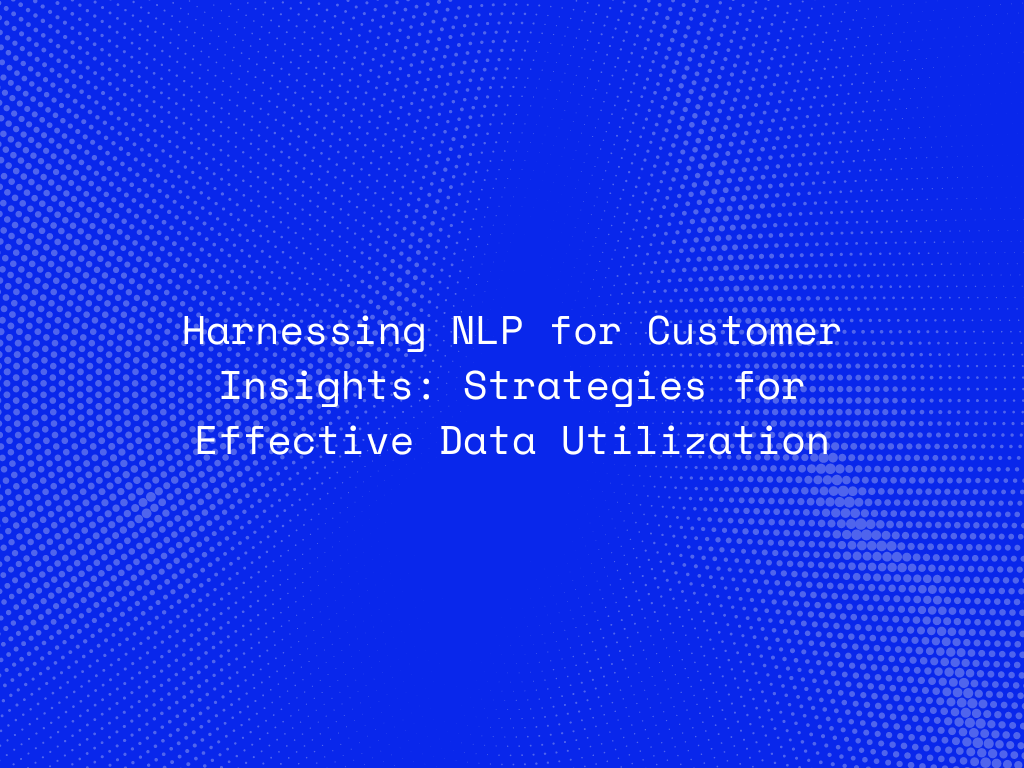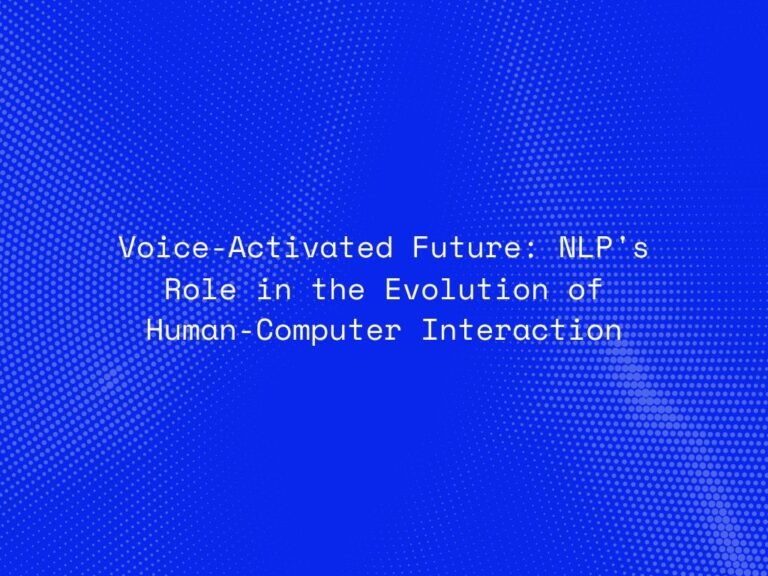Natural Language Processing (NLP), a subset of AI, has become a powerful tool for businesses seeking to unlock valuable customer insights. By analyzing and interpreting human language, NLP can reveal patterns, preferences, and behaviors from vast amounts of unstructured data, such as social media posts, reviews, customer service interactions, and more. These insights enable businesses to make data-driven decisions, improve customer experiences, and enhance their competitive advantage.
In this blog, we will explore how businesses can harness NLP for customer insights and provide strategies for effectively utilizing this data to drive success.
1. Understanding NLP and Its Applications in Business
NLP involves the interaction between computers and human languages, enabling machines to understand, interpret, and generate natural language. NLP applications are wide-ranging, from sentiment analysis and keyword extraction to more advanced uses such as conversational AI, predictive modeling, and voice recognition.
For businesses, NLP provides an opportunity to tap into customer feedback, sentiment, and trends through various channels:
-
Sentiment Analysis: Gauging customer sentiment from social media, reviews, and surveys, NLP can help determine how customers feel about products, services, or the brand.
-
Customer Service Optimization: By analyzing customer service interactions (emails, chat logs, etc.), NLP can identify common pain points, frequently asked questions, and opportunities to enhance the customer journey.
-
Market Research: NLP can analyze customer feedback from multiple platforms to identify market trends, customer preferences, and unmet needs, helping businesses stay agile in competitive environments.
Connect With Us
2. Strategies for Harnessing NLP in Customer Insights
a) Sentiment Analysis for Brand Perception and Product Feedback
One of the most popular uses of NLP is sentiment analysis, which allows businesses to track and understand customer emotions and opinions at scale.
-
Brand Perception: By analyzing customer mentions across social media, blogs, and online reviews, sentiment analysis can reveal whether a brand is perceived positively or negatively. This allows businesses to monitor their brand health and react swiftly to emerging issues.
-
Product Feedback: NLP can extract insights from customer reviews to uncover specific likes and dislikes regarding products. For example, a retail company can analyze customer reviews to find recurring themes such as “quality,” “price,” or “durability,” helping them improve product development.
b) Voice of the Customer (VoC) Programs
VoC programs focus on capturing, analyzing, and acting on customer feedback. NLP plays a critical role in transforming unstructured customer feedback into actionable insights.
-
Text Mining: NLP can process customer comments from multiple sources—surveys, online reviews, call transcripts—to identify common issues, opportunities, or satisfaction drivers.
-
Customer Experience Mapping: NLP helps businesses map out the customer journey by analyzing feedback related to different touchpoints, such as browsing, purchasing, or customer support. By identifying friction points or moments of delight, businesses can create more seamless and enjoyable customer experiences.
c) Keyword Extraction and Topic Modeling for Trend Identification
NLP enables businesses to extract keywords and model topics from large datasets, helping them identify emerging trends and patterns in customer preferences.
-
Keyword Extraction: Businesses can use NLP to extract and rank keywords based on frequency and importance. This can inform marketing campaigns, product features, or even SEO strategies by focusing on what customers are searching for and discussing the most.
-
Topic Modeling: NLP techniques such as Latent Dirichlet Allocation (LDA) can group related words and phrases into topics. This can help businesses understand which themes or topics customers are most interested in and provide targeted solutions.
d) Customer Segmentation through Text Analysis
NLP allows for more sophisticated customer segmentation based on language and sentiment patterns. Rather than relying solely on demographic data, businesses can segment customers based on behaviors, emotions, or preferences expressed in their communication.
-
Behavior-Based Segmentation: NLP can identify distinct behavior patterns in how customers interact with a brand, enabling businesses to create targeted campaigns. For example, customers expressing excitement about a new product launch can be segmented into a group for early access promotions.
-
Emotional Segmentation: By analyzing the emotions conveyed in customer communications (e.g., joy, frustration, or anticipation), businesses can tailor their messaging to resonate with different customer groups, creating more personalized marketing strategies.
Connect With Us
3. Maximizing the Value of NLP-Driven Insights
a) Integrate NLP Insights Across Departments
To fully leverage the potential of NLP-generated insights, businesses should ensure that the findings are shared across key departments:
-
Marketing: NLP insights can fuel content strategies, ad targeting, and influencer marketing by revealing customer interests and trending topics.
-
Product Development: Customer feedback gathered through NLP can guide product enhancements or inform the creation of new offerings that align with customer needs.
-
Customer Support: NLP can help customer support teams identify recurring issues or frequently asked questions, enabling them to develop more effective training programs or automate responses.
b) Enhance Customer Personalization
With NLP, businesses can deliver highly personalized experiences based on customer interactions and preferences. This could include:
-
Tailored Content: NLP can analyze customer language to recommend personalized content, product suggestions, or relevant offers based on their interests.
-
Proactive Customer Support: By predicting customer needs based on prior interactions, NLP can help businesses provide proactive solutions, improving customer satisfaction and loyalty.
c) Leveraging NLP for Competitive Intelligence
Beyond customer insights, NLP can also be used to gather competitive intelligence by analyzing public data on competitors:
-
Competitor Sentiment: NLP can assess customer sentiment related to competitors’ products and services, giving businesses insights into their strengths and weaknesses.
-
Market Positioning: By analyzing market trends and competitive positioning, businesses can identify opportunities for differentiation or innovation.
Connect With Us
4. Challenges and Ethical Considerations in NLP Utilization
While NLP offers significant benefits, businesses must also address the challenges and ethical considerations that come with its use:
-
Data Privacy: NLP requires access to large volumes of customer data. Businesses must ensure they comply with privacy regulations (e.g., GDPR, CCPA) and obtain consent for data collection.
-
Bias in NLP Models: NLP models can inadvertently reflect biases present in training data. Businesses should carefully curate and evaluate data to minimize bias in their AI models.
-
Transparency: It’s essential to be transparent with customers about how their data is being used. Clear communication about NLP-driven processes helps build trust and ensures that customers are comfortable with how their information is handled.
Conclusion
Natural Language Processing offers businesses a powerful tool for unlocking customer insights and driving data-informed decisions. From sentiment analysis and topic modeling to personalized marketing and customer segmentation, NLP can transform unstructured data into actionable intelligence that improves customer satisfaction and enhances competitiveness.
By integrating NLP insights across departments, leveraging them for personalization, and staying mindful of ethical considerations, businesses can fully harness the power of NLP to create meaningful value for their customers and stay ahead in a fast-paced digital landscape.




